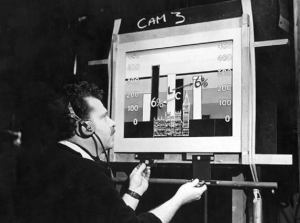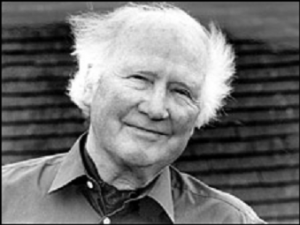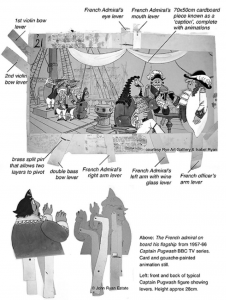Ken Morse
Albert Barber
Ken Morse was a rostrum camera operator who did many credit sequences and inserts.
Keith Wicks
Ken Morse was so well known a few decades ago that one expected him to be credited at the end of almost any TV show, and references were made to him in comedy sketches. For a while, he was even credited at the end of “Week Ending”, and that was a radio show!
Maurice Fleisher
I met Ken a few times during a period when I was sales manager for the Neilson Hordell company that made motion picture animation stands and optical printers. He used Neilson Hordell equipment and knew how to do it brilliantly. He was indeed very well known in the industry, not only for TV credits but also for feature films. This was of course before computers took over and dominated that area of production.
John Bennett
Ken Morse was one of the most familiar names in Television I would think. He was on the actual programme credits of most programmes I remember watching – a legend!
++++++++++++++++++++++
Alfred Wurmser

Alfred Wurmser altering one of the caption cards used to show the state of the parties in the 1951 General Election coverage (this was before the swingometer was invented).
Alec Bray
Any time there was some animation of a graph (tracing a curve for example) or other animation work, the captions used were all called “Wurmsers”: I think in fact that most, if not all, came from the Wurmser studios. The captions were constructed from layers of black card and black paper: the part to be animated was typically white, and was revealed by sliding away a black covering sheet.
Vision control had their part to play here, as the black level of the camera output had to be set so that the lightest part of the black background was in fact below “black level” (or rather, below the black level “pedestal”: the captions often caught some stray light and so the grain of the paper or card could be seen unless the black level was set correctly. Here the Vision Control oscilloscopes were of great use.
A corollary to this story: after leaving BBC Tech Ops and going to College, I taught Maths in a boys’ comprehensive school for some years. I thought I would make a Visual Aid à la Wurmser to show Pythagoras’ theorem. Making those captions animate is not as easy as it looked!

8mm film of a Wurmser style animation to show Pythagoras theorem! (part only!)
John Vincent
Eric Ilett did the animations for “Sky at Night”.
+++++++++++++++++++++++++++
Captain Pugwash
Alec Bray
Many of the early episodes of “Captain Pugwash” were done by the studio crews. We had three or four cameras on cranes, each one pointing down onto a drawing board. On the board there was a background “caption”, on top of which were laid cardboard cutouts of the characters: each part to animate was moved by levers. Each caption (or drawing board) had four of John Ryan’s staff moving the characters in real time. Sometimes, for more complicated scenes, the characters were interleaved between layers of “background” and “foreground”, with the levers sticking out of the sides, top or bottom of the main caption. Everything was help in place with small brass paperclips, glue and sticky tape. As the next camera in sequence was cut to, the operators whisked off the current caption and placed the next one in position on the drawing board. All the voices were done by actor Peter Hawkins. The programme was recorded in real time – we could have gone to live Transmission with “Captain Pugwash”.
In 1987, John Ryan described his view of the programmes:
“… The process of tele-recording was hazardous. Indeed the very first programmes went out live. The method was to set up three sets of captions with three cameras and a monitor each. Peter Hawkins, the narrator, spoke the words in a concealed part of the studio. He had to be invisible because his acting gestures as he spoke all the voices were enough to incapacitate the animators with laughter. After an hour or so of camera rehearsal the programme was recorded, cutting from camera to camera while the operators feverishly operated the captions and then changed them in time for their next appearance. Vision mixing, sound effects and music were all controlled by the producer, Gordon Murray. It was a complex and nerve-racking process, and we were at the mercy of whatever studio staff, electricians etc. happened to be on duty…”
(http://www.captainpugwashexhibition.co.uk/pugwash-tv/#)
John Ryan

(Click on picture to see larger version:
use your browser’s BACK button to return to this page)

John Howell
Ah yes, happy memories of the AFM staggering his/her way into Studio D/E/G Sound Gallery with armloads of 78 RPM FX records to be spun in on the TD7s. A Grams operator was not always scheduled so it was down to a crew member. “It’ll be good experience for you!”
Alec Bray
We also did something similar for CETO again with John Ryan. There was a boy and girl character if I recall correctly, a bit reminiscent of Tom the cabin boy. There were not that many I worked on – in the order of two or three studio days.
Peter Coombes
The CETO programmes would have been the English as a Foreign Language series, produced by Ben Queenan. I don’t remember any of the graphics characters being animated; it was all quasi-rostrum work, with commentary.


